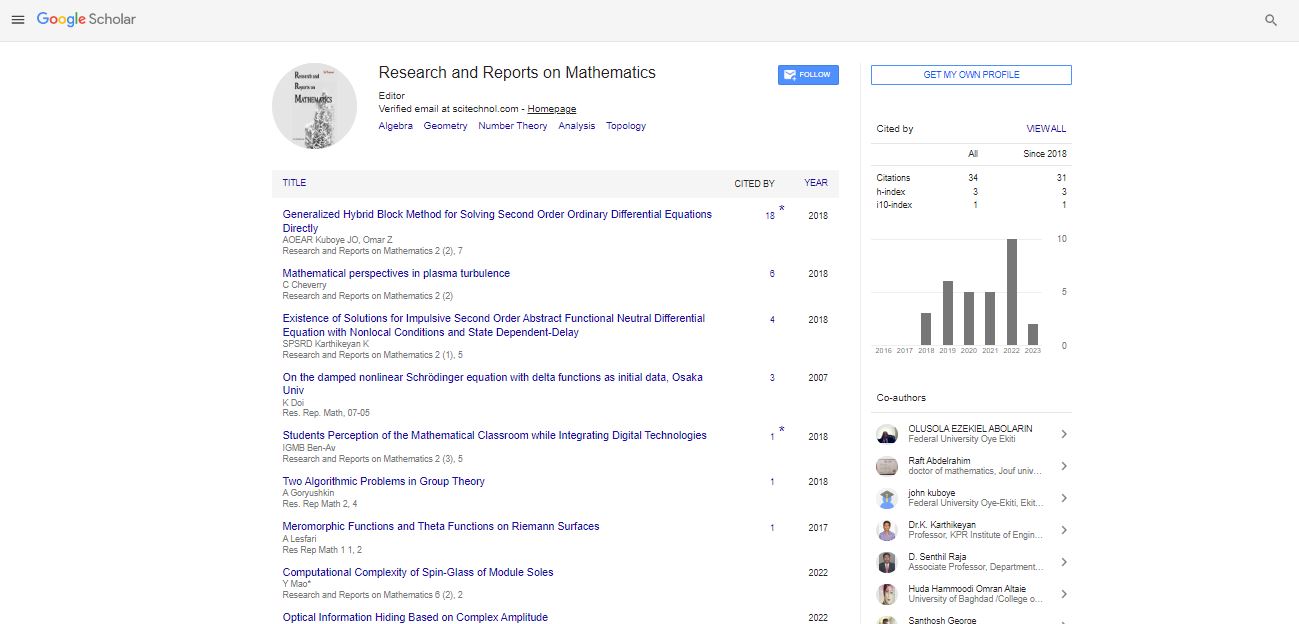Commentary, Res Rep Math Vol: 7 Issue: 5
Challenges and Techniques in Tackling Analytically Intractable Integrals
Ginory Kim*
1College of Mathematics and Statistics, Northwest Normal University, Lanzhou, People's Republic of China
*Corresponding Author: Ginory Kim,
College of Mathematics and Statistics,
Northwest Normal University, Lanzhou, People's Republic of China
E-mail: kimgi@nwnu.edu.cn
Received date: 27 November, 2023, Manuscript No. RRM-24-124953;
Editor assigned date: 29 November, 2023, Pre QC No. RRM-24-124953 (PQ);
Reviewed date: 14 December, 2023, QC No.RRM-24-124953;
Revised date: 21 December, 2023, Manuscript No.RRM-24-124953 (R);
Published date: 28 December, 2023, DOI: 07.4172/rrm.1000214
Citation: Kim G (2023) Challenges and Techniques in Tackling Analytically Intractable Integrals. Res Rep Math 7:5.
Description
Integral calculus, a branch of mathematics developed independently by Sir Isaac Newton and Gottfried Wilhelm Leibniz in the late 17th century, stands as a cornerstone in the edifice of mathematical theory. This profound and intricate field has become an indispensable tool in various scientific disciplines, engineering, economics, and beyond. Integral calculus, in contrast to its counterpart differential calculus, focuses on the accumulation of quantities and the concept of the antiderivative. The birth of integral calculus can be traced back to the late 1600s when Newton and Leibniz independently developed the foundations of the subject. Their groundbreaking work laid the groundwork for understanding the concept of the integral, which represents the accumulation or summation of quantities. Newton used the method of fluxions and fluents, while Leibniz introduced the symbol ∫ (an elongated S), representing integration. The early development of integral calculus was motivated by the need to solve problems related to motion, such as determining the area under curves representing changing velocities or finding the total distance traveled. The resolution of these problems marked the inception of the fundamental theorem of calculus, a key result that established the link between integration and differentiation.
Integral calculus revolves around two primary concepts: definite and indefinite integrals. These concepts are interrelated and form the foundation of the subject. The definite integral represents the accumulation of a quantity over a specific interval. Symbolically, if f(x) is a continuous function on the interval [a, b], the definite integral of f(x) from a to b is denoted as ∫[a to b] f(x)dx. Geometrically, it corresponds to the area under the curve of the function f(x) between the points a and b on the x-axis. The fundamental theorem of calculus establishes a connection between definite integrals and derivatives. It states that if F(x) is an antiderivative of f(x) on [a, b], then ∫[a to b] f(x)dx = F(b) - F(a). The indefinite integral represents the antiderivative of a function. Symbolically, if F(x) is an antiderivative of f(x), it is denoted as ∫f(x)dx = F(x) + C, where C is the constant of integration. The indefinite integral provides a family of functions whose derivatives are equal to the original function f(x). The process of finding the antiderivative is known as antidifferentiation, and it involves reversing the process of differentiation. Techniques such as usubstitution, integration by parts, and partial fractions are employed to evaluate indefinite integrals.
Applications of integral calculus
Integral calculus finds a multitude of applications across various fields, showcasing its versatility and practical significance. One of the fundamental applications of definite integrals is in the computation of areas under curves and volumes of three-dimensional objects. By integrating the function that defines the boundary or cross-sectional area, mathematicians can determine the total area or volume enclosed by a given region. Integral calculus is extensively used in physics and engineering to model and analyze dynamic systems. In mechanics, for instance, integrals are employed to calculate work, energy, and momentum. In electrical engineering, integrals are used in the analysis of circuits and signal processing. Economic models often involve integral calculus to determine quantities such as total profit, revenue, or cost. In finance, integral calculus is used in the calculation of present value, future value, and other financial metrics. In biology, integral calculus aids in the calculation of growth rates, population dynamics, and the analysis of biological processes. In medicine, it is utilized in modeling drug concentrations over time, determining blood flow rates, and assessing physiological responses. Integral calculus plays a crucial role in probability theory and statistics. The probability density function, cumulative distribution function, and moments of random variables are expressed using integrals, providing a mathematical foundation for statistical analysis.
Conclusion
In conclusion, addressing analytically intractable integrals poses significant challenges, necessitating innovative techniques for effective resolution. The complexity of these integrals demands a nuanced approach, involving advanced mathematical methodologies and computational tools. Researchers face the intricate task of developing robust techniques that balance accuracy and efficiency. Despite the formidable challenges, ongoing efforts in devising novel strategies and leveraging computational advancements exhibit promise in conquering analytically intractable integrals, paving the way for enhanced analytical solutions in various scientific domains.
 Spanish
Spanish  Chinese
Chinese  Russian
Russian  German
German  French
French  Japanese
Japanese  Portuguese
Portuguese  Hindi
Hindi 